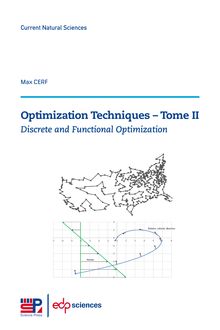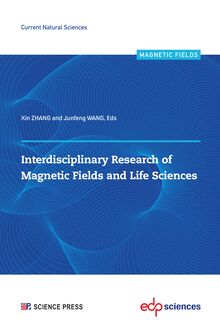-
 Univers
Univers
-
 Ebooks
Ebooks
-
 Livres audio
Livres audio
-
 Presse
Presse
-
 Podcasts
Podcasts
-
 BD
BD
-
 Documents
Documents
-
- Cours
- Révisions
- Ressources pédagogiques
- Sciences de l’éducation
- Manuels scolaires
- Langues
- Travaux de classe
- Annales de BEP
- Etudes supérieures
- Maternelle et primaire
- Fiches de lecture
- Orientation scolaire
- Méthodologie
- Corrigés de devoir
- Annales d’examens et concours
- Annales du bac
- Annales du brevet
- Rapports de stage
La lecture à portée de main
Découvre YouScribe en t'inscrivant gratuitement
Je m'inscrisUltra-cold atoms, ions, molecules and quantum technologies , livre ebook
Découvre YouScribe en t'inscrivant gratuitement
Je m'inscrisEn savoir plus
En savoir plus

Description
The French version of this book was awarded a Special Mention by the jury of the 35th 'Prix Roberval', in the category 'Academic books'.
Physicists know how to produce gases at a few billionths of a degree above absolute zero. The cooling methods apply not only to atoms but also to ions and molecules. This field of research has three times been awarded the Nobel Prize. The field experienced remarkable growth when experimentalists learned how to vary at will the interactions between particles, trapping them with optical tweezers or in optical gratings with adjustable geometry. Artificial crystals made of atoms or molecules can be built to simulate the structure of matter and elucidate some of its magnetic properties, hopefully contributing to the understanding of high-temperature superconductivity. The phenomenon of quantum entanglement is the basis for new devices for the storage and transmission of quantum information. Spectacular progress is constantly being made in metrology. For example, ultra-cold atom or ion clocks measure time to better than one second over the lifetime of the Universe. New types of industrial gravimeters and gyroscopes are improving the sensitivity of seismology and navigation in space. In addition, the extreme precision of the measurements allows tests of the fundamental laws of physics, such as quantum electrodynamics, Lorentz invariance or possible variations of the fundamental constants. The field of ultra-cold particles has now reached the stage where it provides insights in the fields of condensed matter, chemistry and even cosmology.
Preface by Alain Aspect - Nobel Prize in Physics / 2022.
Preamble ................................................... III
Coordinators, Contributors, Sponsors and Acknowledgments ............ VII
Preface ..................................................... XI
CHAPTER 1 Cooling and Trapping Atoms .................................... 1
1.1 When an Atom Meets a Photon ............................. 1
1.1.1 The Atom Slows Down… ............................. 3
1.1.2 … The Gas Temperature Drops ........................ 5
1.2 Atomic Traps of All Kinds ................................. 7
1.2.1 With Lasers and a Magnetic Field: The All-Purpose Trap .... 7
1.2.2 Optical Tweezers to Catch and Immobilize Atoms .......... 9
1.2.3 With Magnetic Fields: From Large Volume Traps to Atomic Chips ............................................ 11
1.3 Even Colder: The Gas Changes State ......................... 14
1.3.1 Last Step Towards the Absolute Zero: We Evaporate ........ 14
1.3.2 Finally, the Grail, the Bose–Einstein Condensation: The Atoms All as One!............................... 15
1.3.3 Atom Boxes Made of Light ........................... 18
1.3.4 Atoms can Attract or Repel ........................... 19
1.4 And the Whole Jungle of Particles on a Microscopic Scale ......... 21
1.4.1 What is Matter Made of? Bosons and Fermions ............ 21
1.4.2 Fermions can also Get Ultra-Cold ...................... 22
1.5 Conclusion ............................................. 23
CHAPTER 2 Cold Atom Instruments and Metrology ............................. 25
2.1 What is Metrology? ...................................... 25
2.1.1 Concepts of Statistical and Systematic Uncertainty ......... 25
2.1.2 Atomsas References................................. 26
2.1.3 Metrology with Quantum Systems ...................... 27
2.2 Atomic Clocks .......................................... 27
2.2.1Principle of an Atomic Clock .......................... 27
2.2.2 Why Use Cold Atoms? ............................... 29
2.2.3 Cold Cesium Atom Clocks ............................ 29
2.2.4 Trapping Atoms to Improve Accuracy ................... 31
2.2.5 Optical Clocks and the Future Definition of the Second ...... 31
2.2.6 Links between Clocks and Time Scales ................... 33
2.3 Atom Interferometers ..................................... 33
2.3.1 Principle of an Atom Interferometer, Similarities and Differences with a Cesium Atomic Clock .............. 33
2.3.2 Inertial Sensors Based on Atom Interferometry ............. 36
2.3.3 Maturity of the Sensors and Industrial Transfer ............ 38
2.3.4 Novel Architectures ................................. 39
2.4 Probing the Fundamental Laws of Physics with Cold Atoms Sensors. . 40
2.4.1 Gravimetry and Chrono-Geodesy ....................... 41
2.4.2 General Relativity and Gravitational Waves ............... 42
2.4.3 Standard Model and Dark Matter ...................... 43
CHAPTER 3 Single Atoms and Single Photons: Quantum Information Exchange ....... 45
3.1 How to See a Single Atom ................................. 46
3.2 The Benefit of Cavities .................................... 48
3.3 Strong Coupling Between a Photon and an Atom: The Rabi Doublet . 50
3.4 The Atom Becomes a Qubit ................................ 51
3.5 Microcavities............................................ 52
3.6 Detecting the State of a Qubit .............................. 54
3.7 Storing Quantum Information in Cold Atoms: Quantum Memories ... 56
3.8 Improving Clocks with Entanglement: Spin-Squeezed States ........ 59
CHAPTER 4 Quantum Simulation with Cold Atoms ............................. 65
4.1 What is Quantum Simulation? .............................. 65
4.1.1 From Classical Matter to Quantum Particles .............. 65
4.1.2 Challenges in Understanding Complex Quantum Systems..... 67
4.2 Ultracold Atoms and Quantum Simulation ..................... 70
4.2.1 Ultracold Gases: Dilute Systems with Complex Collective Behavior......................................... 70
4.2.2 Why are Cold Atoms Good Quantum Simulators? .......... 72
4.3 Observing a Quantum System Atom by Atom ................... 75
4.3.1 Visualizing Atoms in an Optical Lattice .................. 75
4.3.2 Assembling Artificial Crystals Atom by Atom ............. 76
4.4 What can We Simulate with Cold Atoms? ..................... 77
4.4.1Quantum Magnetism ................................ 77
4.4.2 Origin of Superconductivity ........................... 79
4.4.3 Improving our Understanding of Strongly Correlated Materials......................................... 80
4.4.4 Other Prospects .................................... 81
CHAPTER 5 Waves and Disorder ........................................... 83
5.1 Waves and Disorder, very Rich Physical Systems! ................ 83
5.1.1Diffusion in Disorder: an Intuitive Approach… ............. 83
5.1.2...Which Hides a Much More Complex Physics! ............ 84
5.1.3 A Physics also Source of Innovation ..................... 85
5.2 Cold Atoms: Disorder Under Control! ......................... 85
5.2.1 How to Immerse Atoms in Disorder? .................... 85
5.2.2 Random Walk of Cold Atoms in Disorder: Observation of Diffusion ....................................... 88
5.3 Anderson Localization: Halted by Disorder ..................... 89
5.3.1 60Years of Investigations and Still Open Questions ......... 89
5.3.2 An Intuitive Understanding of Anderson Localization ........ 91
5.3.3 Anderson Localization of Cold Atoms: First Observations .... 94
5.3.4 Towards the Study of the Anderson Transition in 3D ........ 95
5.4 Coherent Backscattering: Visualizing Interferences ............... 98
5.4.1 Localization in the Space of Velocities ................... 98
5.4.2 Coherent Backscattering of Cold Atoms .................. 99
5.4.3 Anderson Localization in the Space of Velocities............ 101
5.5 Cold Atoms and Disorder: Other Configurations ................. 102
5.5.1 Universality of Localization Phenomena .................. 102
5.5.2 Light Scattering by Cold Atoms ........................ 102
5.5.3“Kicking” Atoms to Localize Them ..................... 104
5.6 Interactions and Disorder: When Atoms Talk to Each Other ........ 107
5.6.1 Quantum Phases of Disordered Gases at Low Temperature ... 107
5.6.2 Many-Body Localization: When Disorder Makes Thermal Equilibrium Impossible ............................... 109
5.7 Conclusion............................................. 111
CHAPTER 6 Trapping and Cooling Ions ...................................... 113
6.1 How to Confine a Charged Particle? .......................... 115
6.1.1 Penning Trap ...................................... 115
6.1.2 Paul Trap or Radio frequency Trap ...................... 116
6.1.3 Trap Zoology ...................................... 119
6.2 How to Cool Trapped Ions? ................................ 120
6.3 Let Us Put Several Ions in the Trap! .......................... 122
6.4 What can We do with Trapped Ions? ......................... 123
6.4.1 Precision Measurements: Masses, Atomic Properties,…....... 124
6.4.2 Strong Confinement Regime and Ion Clocks ............... 125
6.4.3 Quantum Information and Quantum Simulations ........... 126
6.4.4 Cold Collisions and Cold Chemical Reactions .............. 127
6.4.5 Antimatter Confinement ............................. 127
6.5 Conclusion ............................................. 127
CHAPTER 7
Cold and Ultracold Molecules .................................... 129
7.1 How to Characterize a Molecule? ............................ 131
7.1.1 The Electronic, Vibrational, Rotational Energy Levels ....... 131
7.1.2 Can We Laser Cool Molecules? ......................... 134
7.2 Associating Cold Atoms ................................... 136
7.2.1 With a Photon: Photoassociation ....................... 136
7.2.2 With a Magnetic Field: Magnetoassociation ............... 137
7.2.3 How to Control Association? .......................... 138
7.3 Direct Cooling of Molecules................................. 140
7.3.1 Formation and Preliminary Cooling ..................... 140
7.3.2 Deceleration of Molecular Beams ....................... 141
7.3.3 Sub-Kelvin Cooling ................................. 143
7.4 Cold Molecules: For Which Applications? ...................... 145
7.4.1 Quantum Simulation ................................ 147
7.4.2 Quantum Information ............................... 148
7.5 Ultracold and Controlled Molecular Chemistry .................. 149
7.5.1 Precision Measurements .............................. 152
7.6 Conclusion ............................................. 153
CHAPTER 8 Conclusion and Everything Else This Book Could also Have Been About… . 155
Index ......................................................165
Sujets
Informations
| Publié par | EDP Sciences |
| Date de parution | 01 décembre 2022 |
| Nombre de lectures | 0 |
| EAN13 | 9782759827466 |
| Langue | English |
| Poids de l'ouvrage | 15 Mo |
Informations légales : prix de location à la page 1,1600€. Cette information est donnée uniquement à titre indicatif conformément à la législation en vigueur.
Extrait
-
 Univers
Univers
-
 Ebooks
Ebooks
-
 Livres audio
Livres audio
-
 Presse
Presse
-
 Podcasts
Podcasts
-
 BD
BD
-
 Documents
Documents
-
Jeunesse
-
Littérature
-
Ressources professionnelles
-
Santé et bien-être
-
Savoirs
-
Education
-
Loisirs et hobbies
-
Art, musique et cinéma
-
Actualité et débat de société
-
Jeunesse
-
Littérature
-
Ressources professionnelles
-
Santé et bien-être
-
Savoirs
-
Education
-
Loisirs et hobbies
-
Art, musique et cinéma
-
Actualité et débat de société
-
Actualités
-
Lifestyle
-
Presse jeunesse
-
Presse professionnelle
-
Pratique
-
Presse sportive
-
Presse internationale
-
Culture & Médias
-
Action et Aventures
-
Science-fiction et Fantasy
-
Société
-
Jeunesse
-
Littérature
-
Ressources professionnelles
-
Santé et bien-être
-
Savoirs
-
Education
-
Loisirs et hobbies
-
Art, musique et cinéma
-
Actualité et débat de société
- Cours
- Révisions
- Ressources pédagogiques
- Sciences de l’éducation
- Manuels scolaires
- Langues
- Travaux de classe
- Annales de BEP
- Etudes supérieures
- Maternelle et primaire
- Fiches de lecture
- Orientation scolaire
- Méthodologie
- Corrigés de devoir
- Annales d’examens et concours
- Annales du bac
- Annales du brevet
- Rapports de stage




















